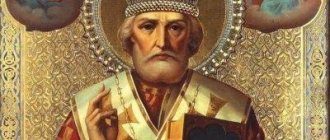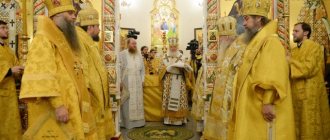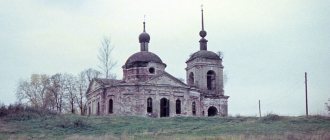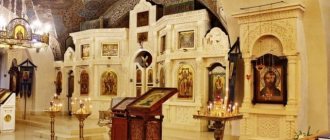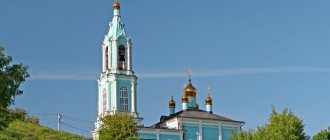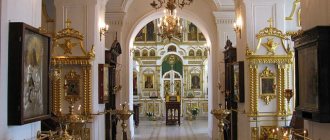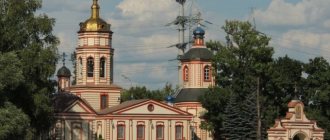Mir
Russia Moscow Church of St. Nicholas of Myra in Zvonary (Moscow) Map is loading...
{"format":"leaflet","minzoom":false,"maxzoom":false,"limit":50,"offset":0,"link":"all","sort":[""], "order":[],"headers":"show","mainlabel":"","intro":"","outro":"","searchlabel":"\u2026 \u0441\u043b\u0435\ u0434\u0443\u044e\u0449\u0438\u0435 \u0440\u0435\u0437\u0443\u043b\u044c\u0442\u0430\u0442\u044b","default":"","import-annotation":false,"width ":"auto","height":"350px","centre":{"text":"","title":"""link":"""lat":55.76417000000000001591615728102624416351318359375,"lon": 37.62306000000000238969732890836894512176513671875,"icon":""},"title":"","label":"","icon":"","lines":[],"polygons":[],"circles":[ ],"rectangles":[],"copycoords":false,"static":false,"zoom":8,"defzoom":14,"layers":["OpenStreetMap"],"image layers":[] ,"overlays":[],"resizable":false,"fullscreen":true,"scrollwheelzoom":true,"cluster":false,"clustermaxzoom":9,"clusterzoomonclick":true,"clustermaxradius":80, "clusterspiderfy":true,"geojson":"","clicktarget":"","showtitle":true,"hidenamespace":false,"template":"","userparam":"","activeicon": "","pagelabel":false,"ajaxcoordproperty":"","ajaxquery":"","locations":[{"text":"\u003Cb\u003E\u003Ca href=\"/palomnik/%D0% A5%D1%80%D0%B0%D0%BC_%D1%81%D0%B2%D1%8F%D1%82%D0%B8%D1%82%D0%B5%D0%BB%D1%8F_% D0%9D%D0%B8%D0%BA%D0%BE%D0%BB%D0%B0%D1%8F_%D0%9C%D0%B8%D1%80%D0%BB%D0%B8%D0% BA%D0%B8%D0%B9%D1%81%D0%BA%D0%BE%D0%B3%D0%BE_%D0%B2_%D0%97%D0%B2%D0%BE%D0%BD% D0%B0%D1%80%D1%8F%D1%85_(%D0%9C%D0%BE%D1%81%D0%BA%D0%B2%D0%B0)\» title=\»\u0425\ u0440\u0430\u043c \u0441\u0432\u044f\u0442\u0438\u0442\u0435\u043b\u044f \u041d\u0438\u043a\u043e\u043b\u0430\u044f \u041c\u 0438\u0440\u043b\u0438\u043a\ u0438\u0439\u0441\u043a\u043e\u0433\u043e \u0432 \u0417\u0432\u043e\u043d\u0430\u0440\u044f\u0445 (\u041c\u043e\u0441\u043a\u 0432\u0430)\»\u003E\ u0425\u0440\u0430\u043c \u0441\u0432\u044f\u0442\u0438\u0442\u0435\u043b\u044f \u041d\u0438\u043a\u043e\u043b\u0430\u044f \u 041c\u0438\u0440\u043b\u0438\ u043a\u0438\u0439\u0441\u043a\u043e\u0433\u043e \u0432 \u0417\u0432\u043e\u043d\u0430\u0440\u044f\u0445 (\u041c\u043e\u0441\u 043a\u0432\u0430)\u003C/ a\u003E\u003C/b\u003E\u003Chr /\u003E\u003Ca href=\»/palomnik/%D0%A1%D0%B2%D0%BE%D0%B9%D1%81%D1%82%D0% B2%D0%BE:%D0%90%D0%BD%D0%BD%D0%BE%D1%82%D0%B0%D1%86%D0%B8%D1%8F\» title=\»\u0421 \u0432\u043e\u0439\u0441\u0442\u0432\u043e:\u0410\u043d\u043d\u043e\u0442\u0430\u0446\u0438\u044f\u003E\u0410\u043d\u043d \u043e\u0442\u0430\ u0446\u0438\u044f\u003C/a\u003E: \u043f\u0440\u0430\u0432\u043e\u0441\u043b\u0430\u0432\u043d\u044b\u0439 \u0445\u0440\u0430 \u043c, \u0441 1996 \u0433 \u043e\u0434\u0430 \u043e\u0442\u043d\u043e\u0441\u044f\u0449\u0438\u0439\u0441\u044f \u043a \u043c\u043e\u0441\u043a\u043e \u0432\u0441\u043a\u043e\u043c \u0443 \u043f\u043e\u0434\u0432\u043e\u0440\u044c\u044e \u041f\u044e\u0445\u0442\u0438\u0446\u043a\u043e\u0433\u043e \u0436 \u0435\u043d\u0441\u043a\u043e \u0433\u043e \u043c\u043e\u043d\u0430\u0441\u0442\u044b\u0440\u044f \u0432 \u042d\u0441\u0442\u043e\u043d\u0438\u0438. \u0417\u0434\u0430\u043d\u0438\u0435 \u043f\u043e\u0441\u0442\u0440\u043e\u0435\u043d\u043e \u0430\u0440\u0445\u0438\u0442\ u0435\u043a\u0442\u043e\u0440 \u043e\u043c \u041a\u0430\u0440\u043b\u043e\u043c \u0411\u043b\u0430\u043d\u043a\u043e\u043c \u0432 1762 \u0433\u043e\u0434 \u0443; \u043a\u043e\u043b\u043e\u043a\u043e\u043b\u044c\u043d\u044f \u043e\u0442\u043d\u043e\u0441\u0438\u0442\u0441\u044f \u043a \u043f\u043e\u0437\u0434\u043d \u0435\u0439\u0448\u0435\u043c\u0443 \u0432\u0440\u0435\u043c\u0435\u043d\u0438.","title":"\u0425\u0440\u0430\u043c \u0441\u0432 \u044f\u0442 \u0438\u0442\u0435\u043b\u044f \u041d\u0438\u043a\u043e\u043b\u0430\u044f \u041c\u0438\u0440\u043b\u0438\u043a\u0438\u0439\ u0441\u043a\u043e\u0433\u043e \u0432 \u0417\u0432\u043e\u043d\u0430\u0440\u044f\u0445 (\u041c\u043e\u0441\u043a\u0432\u0430)","link":"""lat":55.7641700000000000 1591615728102624416351318359375,"lon" :37.62306000000000238969732890836894512176513671875,"icon":""}],"imageLayers":[]}
55.764242; 37.623106
Russia, Moscow, Rozhdestvenka street, 15/8с3
Moscow
Russia
Telephone:
(495) 628-32-28
Church of St. Nicholas the Wonderworker in Zvonary
- an Orthodox church, which since 1996 has belonged to the Moscow courtyard of the Pukhtitsa convent in Estonia. The building was built by architect Karl Blanc in 1762; the bell tower dates back to a later period.
History[edit]
The first church on the site of the modern one appeared during the time of Ivan the Terrible. Then there was a wooden church of St. Nicholas the Pleasant, which was called St. Nicholas of Bozhedomsky, since there was a “wretched house” attached to it, where people who died an unfortunate death were taken for burial. The church, which was mentioned in 1619 as a wooden one, subsequently burned several times and was restored with the help of parishioners, and since 1657 it is already mentioned as a stone one. Then, when the Zvonarskaya settlement was formed on Rozhdestvenka, in which the bell ringers of the Ivan the Great Bell Tower and the guards of the Kremlin churches settled, the church received the name “Nikola in Zvonary”, which was assigned to it in 1677. In 1760, with the money of Count Ivan Illarionovich Vorontsov, who had a large estate nearby, construction of a new stone church began. The author of the project was the famous Baroque architect Karl Blank. Construction of the temple lasted until 1781. The church, built in the Baroque style with a slight influence of classicism, is a tall octagon on a quadrangle elongated from north to south, with a dome and a small traditional onion dome. It is decorated with carved white stone decor, the octagon is decorated with capitals on the corner pilasters, as well as large platbands. In this form, the temple has survived to this day, having undergone minor changes - after the Patriotic War of 1812, two porches and a stone fence were redone, a new two-altar refectory and a bell tower in the classic style were added, and restoration was carried out in 1900.
Interior decoration
In the 1930s, the temple was closed and converted into a warehouse; then there was the drawing department of the Moscow Architectural Institute located nearby.
In 1996, Patriarch Alexy II decided to create a metochion of the Pyukhtitsa Monastery in Moscow, and the Temple of St. Nicholas the Wonderworker in Zvonary was chosen as the main temple for the metochion. Work on the restoration of the temple began in 1994, with the help of three novices of the Pyukhtitsa monastery who moved to Moscow and new parishioners who came to the church. Subsequently, the restoration of the temple was continued by Mosremstroy OJSC.
Russian Orthodox Church
Story
Founded in 1891 on the site of the appearance of the Mother of God. Here are Estonian peasants in the 16th century. They found an icon of the Dormition of the Blessed Virgin Mary in the branches of an oak tree. The Orthodox built a small wooden chapel, and the whole place began to be called Pühtitsa, “holy place” in Estonian. In the pre-revolutionary years, up to ten thousand pilgrims flocked here for the Feast of the Assumption. Soon, next to the wooden chapel, a new, larger one was erected, rebuilt in 1885 into the Assumption Church, where the first Pukhtitsa Orthodox parish was established.
With the participation of the Branch of the Orthodox Baltic Brotherhood from the town of Ievve (now Jykhvi) and the governor, Prince Sergei Shakhovsky, the Pyukhtitsa Assumption women's community was founded here, which was soon transformed into a monastery. The patronage and spiritual support of the monastery was provided by the holy righteous John of Kronstadt.
Thanks to the efforts of Metropolitan Alexy (Ridiger) of Tallinn and Estonia, the monastery was not closed in the post-war years. On his initiative, in 1986 a house was built in the monastery for “representative purposes” with the house church of St. Alexis and the Great Martyr Barbara.
In 1990, the monastery complex was expanded to include the baptismal church of John the Baptist.
In 2010, the monastery hosted celebrations on the occasion of the 100th anniversary of the Assumption Church.
In 1968-2011 the abbess of the monastery was schema-abbess Varvara (Trofimova). Mother Varvara died on February 8, 2011.
By the decision of the Holy Synod of October 5, 2011 (journal No. 128), nun Philareta (Kalacheva), who was acting after the death of Mother Varvara, was appointed abbess of the monastery. abbess of the monastery.
There are currently 122 sisters in the monastery. The Pukhtitsa nuns carry out obedience in the Gornensky monastery of Jerusalem, in the metochions in Moscow and Kogalym, in the Iliinsky monastery of Vasknarva, fourteen former nuns of the monastery headed the newly opened monasteries of the Russian Orthodox Church.
Temples
- Cathedral of the Assumption of the Blessed Virgin Mary (1910);
- refectory church of St. right Simeon the God-Receiver and Anna the Prophetess (1895);
- temple of St. Sergius of Radonezh (1895);
- temple of st. Nicholas and etc. Arseny the Great (1885, in the cemetery);
- Baptismal Church of John the Baptist and Sschmch. Isidor Yuryevsky (1990);
- house church of St. Alexia and VMC. Barbarians (1986).
Monastic monastery in the village. Vasknarva: in honor of the prophet Elijah (1873, restored in the early 70s of the 20th century, opened in September 2002).
Compound of the monastery in Moscow: Church of St. Nicholas the Wonderworker in Zvonary (Rozhdestvenka St., 15/8, tel. (495) 628-32-28).
Compound of the monastery in Kogalym (Khanty-Mansiysk Autonomous Okrug - Ugra). Founded 1998
Shrines
The revealed icon of the Dormition of the Mother of God, the Pukhtitsa icon of the Mother of God “At the Source”, the icon of St. Nicholas, icon of the Military Medical Center. Barbarians with a particle of relics, a marching image of Emperor Peter I - an icon of the Savior, the Vladimir and Chernigov icons of the Mother of God, an icon of the Great Martyr. Panteleimon and others.
***
Brief historical sketch
Patronal holidays[edit]
Nicholas the Wonderworker, Archbishop of Myra, Saint
— May 22, December 19
Annunciation of the Blessed Virgin Mary
— April 7
Demetrius of Rostov, saint
— October 4 (discovery of relics), November 10
Alexy of Moscow, saint, wonderworker
- 25 February
Sergius of Radonezh, Venerable
— Cathedral of Moscow Saints, July 18, October 8
Beheading of the Prophet, Forerunner and Baptist of the Lord John
- 11 September
Dormition of the Blessed Virgin Mary
- August 28]
Ordering commemorations
The Mother of God Nativity Monastery and the Church of St. Nicholas the Wonderworker in Zvonary - courtyard of the Pukhtitsa Monastery
The Russian winter this year still will not gain its legal force. But the weather, nevertheless, is far from summer. In order not to expose the parishioners of our temple to hypothermia, it was decided in the winter to focus on shrines, one might say, within walking distance. Moreover, the Mother See abounds in shrines. On December 12, a large group of pilgrims from our church, led by priest Pavel Karev, visited the Mother of God Nativity Stauropegial Convent and the Church of St. Nicholas in Zvonary - the patriarchal metochion of the Estonian Pukhtitsa Holy Dormition Stauropegial Convent, all on Moscow Rozhdestvenka Street.
Stavropegia literally translated from Greek means “raising the cross.” In the Church, stauropegy means a status assigned, as a rule, to Orthodox monasteries and making them independent of local diocesan authorities and subordinate directly to the Patriarch.
The Mother of God Rozhdestvensky Monastery was founded in 1386 by the wife of Prince Andrei Serpukhovsky and the mother of the hero of the Battle of Kulikovo, Prince Vladimir the Brave - Princess Maria Konstantinovna. Princess Maria Konstantinovna took her hair here before her death with the name of Martha in 1389. Over time, the monastery gave its name to the street, which was originally the road leading to the monastery. The current main monastery stone Cathedral of the Nativity of the Blessed Virgin Mary was erected in 1501-1505 on the site of the previous one, from which remains of the foundation masonry have been preserved.
In 1525, in the Nativity Monastery, under the name Sofia, the wife of Vasily the Third, Solomonia Saburov, was forcibly tonsured. Nun Sophia lived here before her transfer to the Intercession Monastery in Suzdal. Subsequently, Solomonia Saburova was canonized by the Russian Orthodox Church as St. Sophia of Suzdal (December 29 (December 16, old style). The icon of St. Sophia of Suzlal with a particle of relics is now one of the shrines of the Moscow monastery.
In the second half of the 17th century, the monastery became the burial place of the Lobanov-Rostov princes. The princely family supported the monastery. Thus, the stone Cathedral of St. John Chrysostom was built in 1676-1687 through the efforts of Princess Photinia Ivanovna Lobanova-Rostovskaya. Also, at her expense, a stone fence with four towers was erected.
In the 19th - early 19th centuries, a bell tower with a gate church of the Holy Martyr Eugene, Bishop of Kherson (1835-1836, in the style of late classicism) and a refectory church of the Kazan Icon of the Mother of God in the Russian-Byzantine style (1904-1906) were built in the Nativity Monastery. The vaults and walls of the Church of the Kazan Icon of the Virgin Mary are made in the style of the art school of the late 19th - early 20th centuries (modern).
In 1922 the monastery was closed. Abbess Yuvenalia and several sisters ended up in the Gulag. Most of them were tortured and killed in the 1930s. The nun of the monastery, Tatiana (Besfamilnaya), was subsequently added to the Council of New Martyrs and Confessors of the Russian Church.
The monastery housed various institutions; some of the cells were given over to communal apartments. Some nuns were allowed to remain in the former monastery. Two nuns lived on the territory of the monastery until the 1970s.
During the Soviet years, the monastery cemetery (along with the grave of the founder) and the garden were destroyed, and part of the walls were demolished. Many buildings were not repaired and fell into complete disrepair.
In 1974, part of the buildings of the Nativity Monastery was transferred to the Moscow Architectural Institute for the organization of a museum-reserve of ancient Russian art and architecture. The restoration of the bell tower and the Nativity Cathedral, which housed the archives of one of the research institutes, was carried out. In the late 1980s, some of the premises were occupied by various companies and tenants.
In 1989, the Church of the Nativity of the Blessed Virgin Mary was returned to the Russian Orthodox Church. In 1993, a decision was made to revive the ancient monastery. The first nuns of the monastery were nuns from the Estonian Pukhtitsa Monastery. From the first days, the abbess of the Mother of God Nativity monastery was nun Victorina (Perminova), who in 1998 was elevated to the rank of abbess. Restoration work is continuously carried out in the monastery. Basically all the churches of the monastery have already been restored, except for the Cathedral of St. John Chrysostom, where before any work can begin it is necessary to go through an infinite number of various approvals.
Many of our pilgrims came to the monastery early in the morning for the Divine Liturgy, where our priest Pavel Karev served with the monastery priest, Father Roman Chistikov, and they confessed and received communion. The parishioners of our church venerated the shrines of the monastery, among which, in addition to the already mentioned icon, St. Sophia of Suzdal is still a particle of the relics of St. the Great Martyr George the Victorious in the ark, the icon of the holy great martyr and healer Panteleimon with a particle of the relics of the saint, the miraculous icon of the holy righteous Simeon of Verkhoturye with a particle of the relics, other relics of the monastery. At the end of the service, at half past ten, a tour of the monastery began, which was wonderfully conducted by the resident of the monastery, Mother Sergia. Our pilgrims were greatly impressed by the leisurely monastic service, temple icons and shrines, expressive images of the refectory church, and the scope of restoration work.
At the end of the excursion, our pilgrims moved to the nearby Church of St. Nicholas the Wonderworker in Zvonary.
The first church on the site of the modern temple appeared in the time of Ivan the Terrible. It was a wooden church of St. Nicholas of Bozhedomsky, since a “poor house” was organized near it, where in winter the bodies of dead tramps and drowned people, people who died an unfortunate death, were taken and left until the spring until the next burial. The temple, which burned repeatedly since 1657, has now been rebuilt as a stone one. Gradually, Zvonarskaya Sloboda was formed on Rozhdestvenka, in which the bell ringers of the bell tower of Ivan the Great and the guards of the Kremlin churches settled, which is why the temple began to be called “Nicholas in Zvonary”. This name was officially established in 1677. In 1760, with the money of Count Ivan Ilarionovich Vorontsov (who had an estate nearby), according to the design of the architect Karl Blank, construction began on a temple in the Baroque style with a slight influence of classicism. Construction was completed in 1781.
In 1933 the temple was closed. Its premises housed a warehouse. There were repeated threats of demolition. Since the mid-1960s, the Department of Drawing of the Moscow Architectural Institute has been located in the temple building.
In 1993, His Holiness Patriarch Alexy II signed a decree on the formation of the Pyukhtitsa Monastery at the Church of St. Nicholas in Zvonary. Work on the restoration of the temple began in 1994, and in 1996, His Holiness Patriarch Alexy II performed the great consecration of the main altar and two side chapels of the temple. The abbess of the metochion is Abbess Philareta (Smirnova), a long-time assistant to the late Patriarch.
The main altar of the temple is now consecrated in honor of the Annunciation of the Blessed Virgin Mary. One of the side chapels is named after St. Nicholas. Another chapel is consecrated in memory of the Beheading of John the Baptist.
Mother Adriana (Malysheva), whose beginning of spiritual life is inextricably linked with our Church of the Resurrection of the Word, took part in the restoration of the temple, the creation of a monastic community, until her death in 2012. The difficult life path of Mother Adriana is reflected in the book “Nun from Intelligence,” which some time ago could be purchased in the bookstore of our church.
Shrines of the temple: revered icons of the Dormition of the Mother of God and the Theotokos “Seeking the Lost.” The icon of the Mother of God “Seeking the Lost” was donated to the church by a noble family at the beginning of the 19th century. After the closure of the temple, she wandered for a long time through the storehouses of various Moscow churches being destroyed by the authorities, until she was saved by one pious woman and transferred by her in 1981 to the Estonian Pukhtitsa Monastery. When the Moscow courtyard of the monastery was created, the icon, having made such a difficult journey, again took its rightful place in the Church of St. Nicholas in Zvonary.
The obvious spiritual connection between our Church of the Resurrection of the Word and the Church of St. Nicholas in Zvonary is surprising. This was noted by all participants in our pilgrimage. Having left the courtyard fence, our parishioners again plunged into the noisy and bustling life of a huge metropolis...

